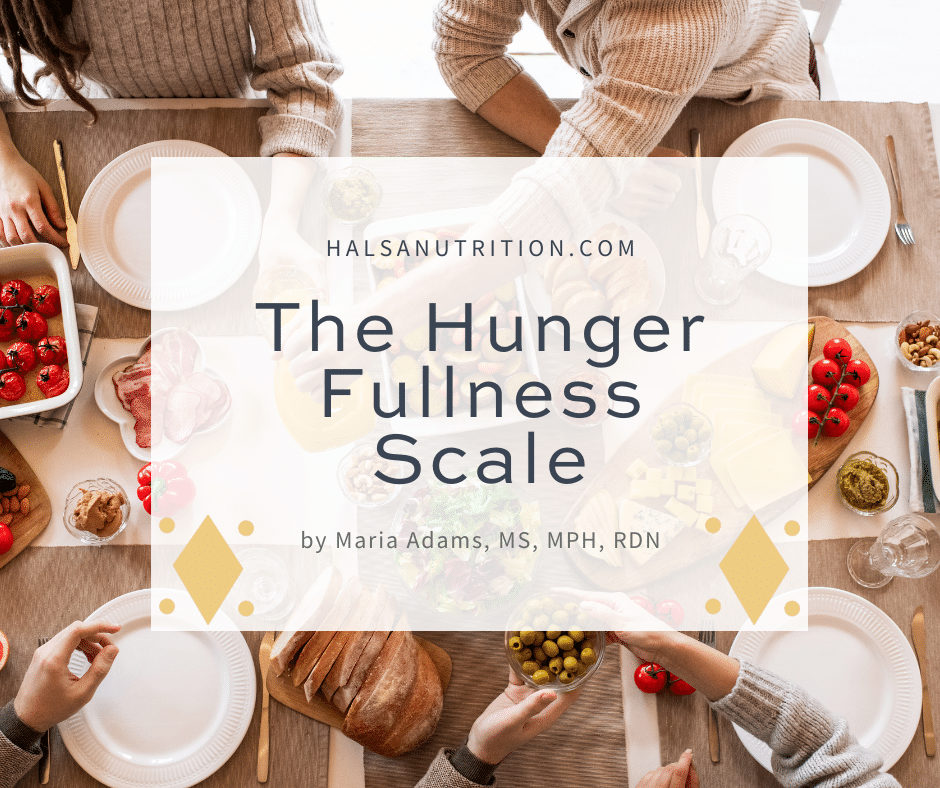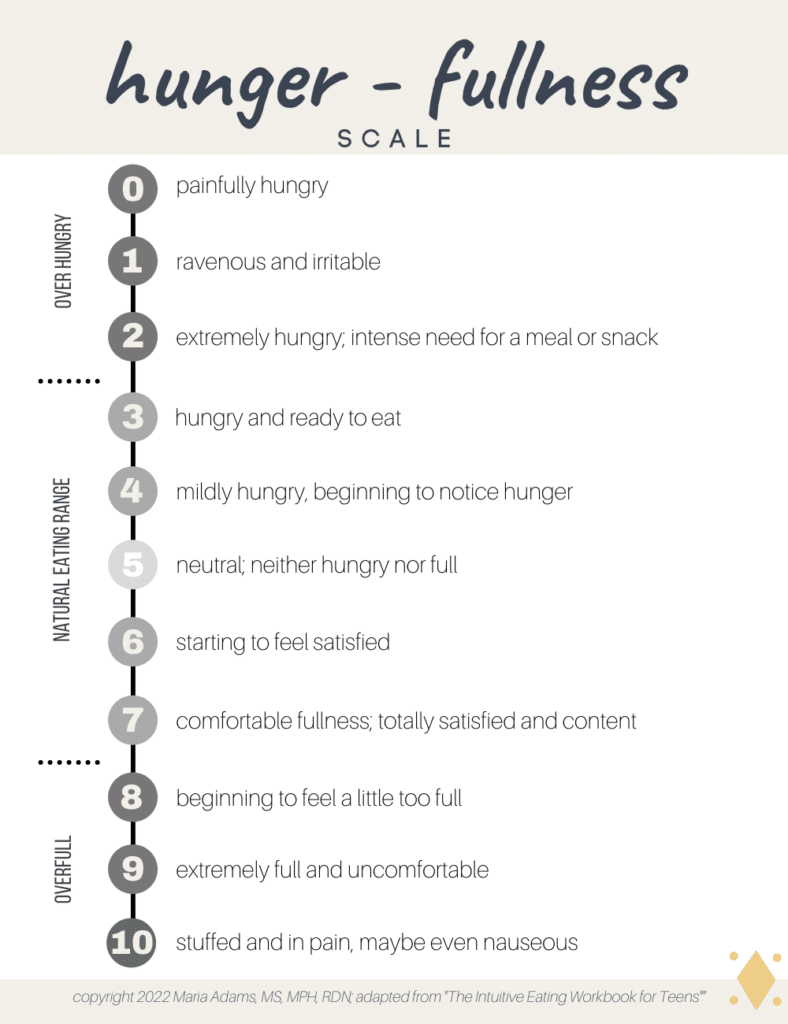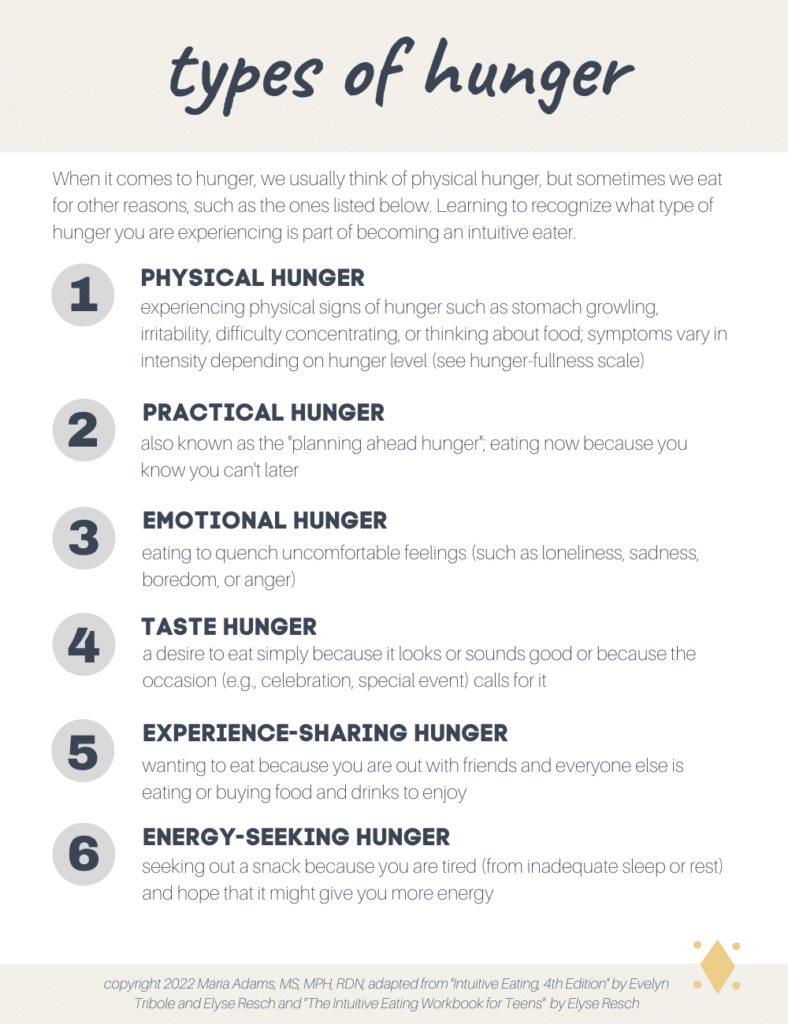
The Hunger Fullness Scale
The hunger fullness scale is a helpful tool for understanding your body’s hunger and fullness signals. Tuning into these cues can help you become a more intuitive eater.
Estimated reading time: 7 minutes
What is the Hunger Fullness Scale?
The hunger fullness scale is a tool that can help you rate your feelings of hunger and fullness on a scale of 0-10. A level 0 is painfully hungry, a 5 is neither hungry nor full, and a level 10 is painfully full.
The body sends signals for us to eat when we are hungry and stop when we are full. When we honor our body’s cues, we will usually find ourselves eating at a hunger level of 3-4 and stopping around level 7. This is part of intuitive eating.

Why is This Tool Helpful?
Learning to tune into your hunger and fullness will help you become a more intuitive eater.
For example, if you have a habit of becoming over-hungry and then eating ravenously as a result, this tool can help you recognize subtle signs of hunger that might be occurring before you are over-hungry. Learning to eat earlier can help you feel better and decrease the occurrence of ravenous hunger. Likewise, the hunger fullness scale can help teach you what comfortable fullness feels like.
What if I Can’t Tell When I’m Hungry or Full?
If you have been dieting or restricting for a while, it’s likely that you have gotten out of touch with your hunger and fullness cues. This is sometimes referred to as having a “broken satiety meter.”
Establishing regular mealtimes can help reconnect with your hunger and fullness cues. Eventually, you will become a more intuitive eater and be able to rely more on your body’s sensations than the time on the clock–though chances are you will see a natural pattern reappear.

Most people need to eat every 3-5 hours during the day. This is because the liver runs out of stored carbohydrates every 3-6 hours. (Tribole E., Resch E., Intuitive Eating. 2020). If you get hungry 1-2 hours after eating it may mean that you didn’t eat enough at the previous meal. This is ok if you prefer to graze, but something to be aware of.
Being mindful during the day and sticking to regular mealtimes can help you avoid becoming over-hungry (or going below a 3 on the hunger scale). Keeping an energy bar in your bag is also helpful for those days when you are on the go. Once you are eating, doing so slowly and mindfully can help you sense when you are starting to get full.
Should I Only Eat When I’m Hungry?
It’s a common misconception that you should only eat when you are hungry. (Just like many people mistakenly think of intuitive eating as the hunger-fullness diet). While yes, we should eat when we are hungry, there are many other reasons for eating too.
Here are some of the different reasons why we eat. You can think of these as the different types of hunger. The next section explains some of the many different types of hunger.
The Different Types of Hunger
(Adapted from “Intuitive Eating, 4th Edition” by Evelyn Tribole and Elyse Resch and “The Intuitive Eating Workbook for Teens” by Elyse Resch)
Physical Hunger – This is biological hunger. Your body’s digestive system, blood sugar levels, brain, and hormones communicate that it’s time to eat. Two hormones that get released when we are hungry are ghrelin (also known as the hunger hormone) and neuropeptide Y. With biological hunger you may experience stomach growling, irritability, difficulty concentrating, or thinking about food. Symptoms vary in intensity depending on hunger level.
Practical Hunger – This is also known as “planning ahead hunger”; eating now because you know you can’t later. Examples of practical hunger include eating a pre-workout snack and eating an extra big breakfast because you know you won’t be able to eat again until lunchtime.
Emotional Hunger – This is eating to quench uncomfortable feelings such as loneliness, sadness, stress, boredom, or anger. We are human and it’s normal to eat for emotional reasons now and then. But if it’s happening often, it’s a sign that you may benefit from working on your relationship with food. Part of becoming an intuitive eater is recognizing that this is happening and learning other ways to cope with emotions. But intuitive eating also entails approaching your thoughts and actions with curiosity, not judgment. It’s recognizing that you ate for emotional reasons and trying to understand without feeling shame or guilt.
Taste Hunger – This is the desire to eat simply because it looks or sounds good or the occasion calls for it. It could be a birthday celebration with cake, the presence of freshly baked cookies, or walking by a pizza place that smells so good you suddenly feel hungry.
Experience Sharing Hunger – This is wanting to eat because you are out with friends and everyone else is eating or buying food and drinks to enjoy. This is especially common for teens who may be experiencing the excitement of being able to go to the convenience store or nearby coffee shop for snacks after school. But it also happens among adults. For example, you may hesitate to stop by a cafe and order a pastry on your own, but with a friend, it’s more fun and enjoyable. Meeting friends for drinks could also be considered experience-sharing hunger.
Energy Seeking Hunger – This is seeking out a snack because you are tired and you think it may give you a boost of energy. This can happen after a poor night’s sleep or during a stressful day.

Why Do I Sometimes Eat Beyond the Point of Fullness?
One of the most common reasons for eating beyond the point of comfortable fullness is going too long without eating. Planning shorter intervals between meals and eating when you are just starting to get hungry can help.
Other reasons for eating until we are uncomfortably full include
- Restrictive eating–not eating enough food or not giving yourself permission to eat what you really want
- Emotional eating
- Taste hunger–whether it’s the most delicious freshly baked cookies, an all-you-can-eat brunch, or a Thanksgiving feast
- Distracted eating–not being mindful of what we are eating or tasting, and having the “diet starts tomorrow” (or “last supper”) mentality
What is the Difference Between Fullness and Satisfaction?
Sometimes we may eat until we are full, but still not feel satisfied. This is because fullness and satisfaction are different. Fullness is more of a physical feeling while satisfaction is the brain’s interpretation of how you feel.
Here are some tips for improving your satisfaction:
- Include a variety of food groups at each meal and aim to have all the 3 macronutrients (protein, carbohydrates, and fat) present
- Add a variety of colors, textures, and flavors to your plate
- Mix it up; eating the same thing every day can lead to boredom
- Practice mindful eating; be present, eat slowly, and really taste and savor your food
- Eat what you are craving! As my colleague, Audrey Young, MS, RDN, CDES says, “If you want a cookie, eat a cookie!” Likewise, if you are craving a burger, don’t order just a salad, at least get a burger and a salad.
- Have dessert! Sometimes a little piece of dark chocolate is all that is needed to complete the meal, other times it’s a full-sized brownie with ice cream!
Takeaway
Learning to tune into your hunger and fullness will help you become a more intuitive eater. The hunger fullness scale is a great tool to help you identify what you are feeling before and after you eat.
For more individualized help, consider meeting with an intuitive eating counselor or non-diet dietitian to help you reestablish your hunger and fullness cues and identify triggers for over and undernourishing.
References
Disclosure: These are Amazon affiliate links. As an Amazon Associate, I earn from qualifying purchases.
- “Intuitive Eating, 4th Edition” by Evelyn Tribole and Elyse Resch
- “The Intuitive Eating Workbook for Teens” by Elyse Resch
Purchase a printable hunger-fullness scale and types of hunger handout here. Thank you so much for your support!
Leave a Reply